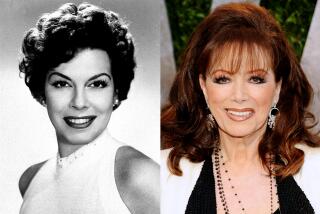Alice Adams; Novelist, Short-Story Writer
Alice Adams, whose acutely observed and elegantly written novels and short stories focused on womenâs struggles to find meaningful lives, died Thursday in San Francisco.
She was 72 and had been treated for heart problems a few days before her death, said Victoria Wilson, her editor for the last 25 years.
A native of Fredericksburg, Va., who moved to California in the 1950s, Adams wrote 10 novels, including the best-selling âSuperior Women,â and five collections of short stories, many of which first appeared in the New Yorker.
Knopf, which published nearly all her books, will release her last novel, âAfter the War,â next year.
Adams specialized in contemporary American relationships, particularly among urbane, white middle- or upper-middle-class women. She often was described as an old-fashioned writer whose books and stories read well because of their underlying qualities: âthe Dickensian coincidence, the solemn omniscience, the sense of lives destined to intertwine,â Sheila Weller wrote in Ms. magazine.
âShe was sort of a magician,â Wilson said. âShe managed to give you a dimensional quality of people and place and situation in a very, very condensed amount of space. Youâd be reading three simple sentences and have the whole resonance of a person.â
Adams was born in Virginia on Aug. 14, 1926, but grew up in Chapel Hill, N.C. Her father taught Spanish at the University of North Carolina and her mother struggled to be a writer.
She attended Radcliffe College, graduating when she was 19, and married a Harvard student, Mark Linenthal. They lived a while in Paris, then moved to San Francisco in 1948. The couple divorced in 1958, leaving Adams to raise their son, Peter, who survives her.
While struggling to earn a living through bookkeeping and secretarial work, Adams began to write seriously. Her first novel, âCareless Love,â was published in 1966 to mixed reviews.
Almost 10 years passed before her next book came out. But âFamilies and Survivors,â which followed two sisters through the the ups and downs of life over three decades, established her as a novelist.
Her breakthrough came in 1984 with âSuperior Women,â about the friendship of four young women forged during their years at Radcliffe. Often compared to Mary McCarthyâs novel âThe Group,â which followed eight women through Vassar College in the 1930s, Adamsâ work traced the lives of her characters beyond graduation and showed how they were affected by political and social currents, from civil rights to Watergate.
John Updike, reviewing âSuperior Womenâ in the New Yorker, wrote: âThe novel . . . reads easily, even breathlessly; one looks forward, in the chain of coincidences, to the next encounter, knowing that this author always comes to the point from an unexpected angle, without fuss.â
Many critics admired the compactness of Adamsâ writing, a talent that served her well in short stories. Critic Katha Pollitt, writing in the New York Times Book Review, said the typical Adams story âannounces itself in the very first sentence as a thing of edgy wit and compressed narrative power.â
Twenty-two of her stories appeared in O. Henry Awards collections, as well as in several volumes of âBest American Short Stories.â Adams also was the recipient of an Academy and Institute Award in literature from the American Academy and Institute of Arts and Letters.
Not all critics were enamored of her writing. Some, like Pollitt, felt that she relied too heavily on one type of âsupremely sheltered, idle, unexaminedâ heroine. Others found fault with characters who too often lacked passion.
But many critics agreed that Adamsâ ability to evoke the inner struggles of a certain kind of well-educated, well-traveled woman and to capture a particular era or social milieu, such as San Francisco in the 1980s, was a major accomplishment.
Much of her fiction took place in San Francisco, her adopted hometown. Cyra McFadden, a Bay Area novelist and journalist who knew Adams for 20 years, said so many of her characters âlived here and inhabited their houses and their social circles so vividly [that] you half expected to meet them at the next dinner party you went to--the one given by the well-heeled, deeply unhappy hosts.â
Her writing was not autobiographical per se, although a constant theme was the complexity of friendships. Novelist Diane Johnson, who knew Adams for 30 years, said that although she had a reputation for being difficult, Adams was a âpowerful friendâ who took nothing in relationships for granted.
Her 1988 novel âSecond Chances,â about a group of long-time friends facing the onset of their 60s and the stigma of old age, also reflected a personal preoccupation: Adamsâ realization that she was nearing 60 herself.
âI have the perception that people talk about old age in two ways,â she told an interviewer for the New York Times Book Review when âSecond Chancesâ was released. âOne is to focus on the horrors of it, not that they should be underestimated, and the other is to romanticize it.â
Adams, a striking woman with silver hair and a highly developed sense of style, was accused by one reviewer of presenting too pretty an image of senility. In her own life, advancing age in the 1980s brought particular horrors--a bout of colon cancer and a traumatic operation to remove a malignant tumor between her eyes.
But when Adams recovered from the last operation, Wilson said, âshe went back and wrote three more books,â including the 1997 novel âMedicine Men,â in which the central character was a woman who had cancer.
âShe had an incredible spirit,â Wilson said, âa radiance and youthfulness that made you think she was going to be there forever.â
More to Read
Sign up for our Book Club newsletter
Get the latest news, events and more from the Los Angeles Times Book Club, and help us get L.A. reading and talking.
You may occasionally receive promotional content from the Los Angeles Times.







